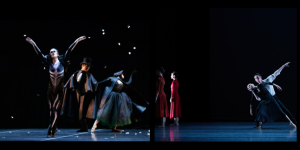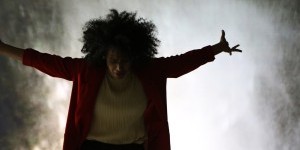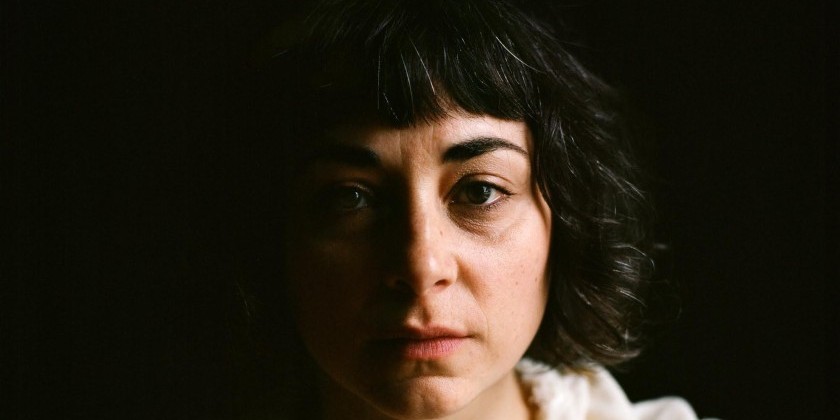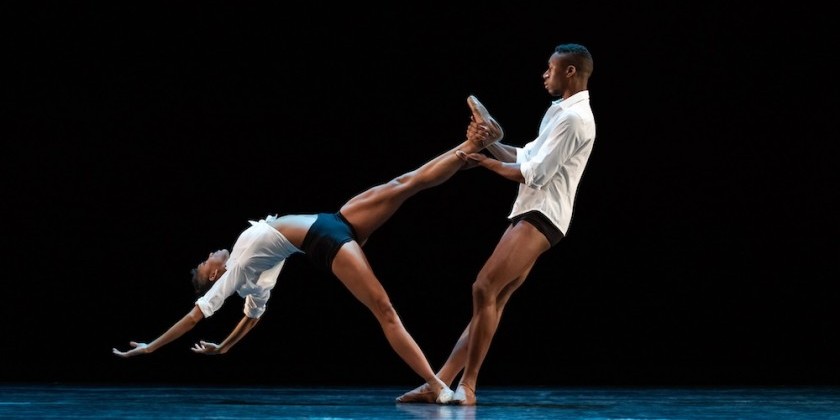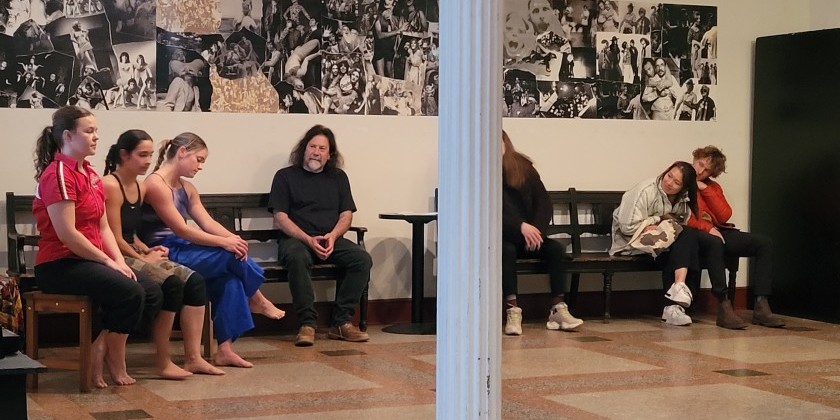IMPRESSIONS: New York City Ballet's 75th Anniversary Season — Balanchine, The Entertainer
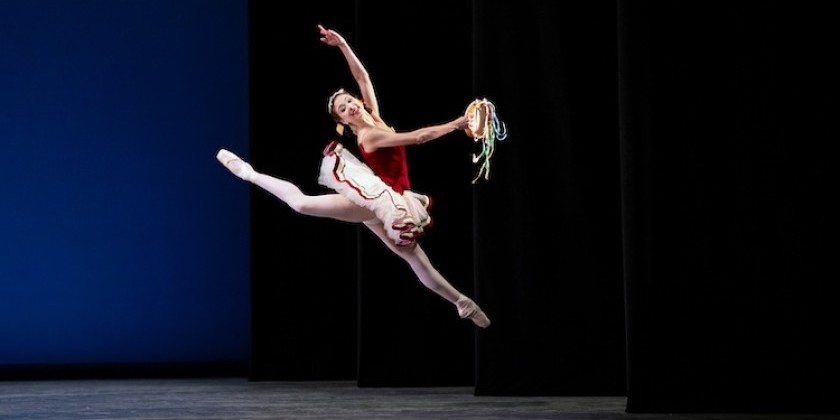
New York City Ballet
75th Anniversary Season, September 19 – October 15, 2023
David H. Koch Theater, Lincoln Center, New York City
Tuesday & Friday, September 26 & 29
In the second week of its 75th-anniversary fall season, New York City Ballet presents two programs that measure high on the entertainment scale. On Tuesday night, Western Symphony, Tarantella, and Stars and Stripes seem like a generous serving of whipped cream on cannoli with lots of sprinkles on top. Thankfully the dancers outdo themselves and make this overload of sweetness more than palatable.
Olivia McKinnon and Gilbert Bolden III debut in the first movement of George Balanchine’s cowboy fantasy Western Symphony, set to American melodies of yesteryear arranged by Hershy Kay. Bolden inhabits his role with gusto and glee. His winsome smile and attentiveness toward his partner make him a gallant denizen of the wide-open plains and the lone yet frolicsome dance hall that serves as the locale. His swagger belies the fact that he is taking on a new role. He invites McKinnon for the ride, and even the audience is eager to jump on his wagon. In the ballet’s slow central movement, Jovani Furlan debuts alongside the elegant Indiana Woodward. With the camp factor at maximum level, he snaps imaginary reins and drives a team of bourréeing ladies offstage. Emily Kikta’s long, high-kicking legs entice veteran performer Andrew Veyette to gambol, spin, and jump. Think of this duet as ballet’s answer to Irving Berlin’s “Anything you can do (I can do better),” and you will delight in the playful one-upmanship. Cowboy hats fly in all directions, and the dancers continuously pirouette as the curtain comes down in the work’s grand finale.

Emily Kikta and the Company in George Balanchine’s Western Symphony. Photo by Erin Baiano
What is probably meant as an attempt at seriousness in programming turns out to be nothing more than a shot in the dark. "The Unanswered Question", an excerpt of Balanchine’s 1954 Ivesiana, is hampered by a last-minute-cast-change . The short ballet never lets the female dancer put her feet on the ground. Intricate mid-air partnering requires trust which might have been established in subsequent showings.
The exuberant Tarantella comes along as the perfect showpiece for evergreen spitfire Daniel Ulbricht. Balanchine had choreographed the eight-minute pas de deux to show off the virtuosity of star dancers Patricia McBride and Edward Villella in 1964. With tambourines and lots of panache, the dancers flirt while joyfully demonstrating pyrotechnics. Erica Pereira’s sweet-natured portrayal gives Ulbricht room to pull out all the stops. Hats off to him and his enduring mastery and prowess.

Just like the program’s opening number, the ballet that concludes the evening, Stars and Stripes, is yet another Balanchine homage to America. Regiments of short and tall women wearing either pink or blue tutus strut across the stage before a battalion of men execute symmetrical maneuvers in perfect unison like wound-up toy soldiers. The guys are having so much fun that one cannot help but smile at this overdose of hokeyness. But Balanchine saves the best for last: Liberty Bell and El Capitan get to dance together! Vivacious Megan Fairchild knows she is in good hands and plunges into multiple arabesque turns while her expert partner, Roman Mejia, just happens to walk across the stage to catch her ever so casually at exactly the right moment. He whips through his turns and jumps high up in the air with flexed feet. One moment a bouncy ball and the next a danseur noble, Mejia is more than a chameleon: he is a gift to the art form.

While the dancing on stage delights balletomanes, a display of moving images on three giant panels hung outside the theater facing Lincoln Center Plaza attract attention during the season, and possibly help bring new audiences to the ballet. The slow-motion sequences give the spectator a close and serene look at movements that one might miss due to their speed when performed on stage. I applaud the company’s efforts to make ballet visible to a general public and lure passersby to purchase tickets. Inside the theater, costumes in display cases generate further excitement and give insight into the creation of the designs. Weekly transformations of these displays keep audiences busy during intermissions. What a wonderful new addition to a New York City Ballet experience! My hope is that the everchanging exhibit will continue every season.

Emma Von Enck and Sebastian Villarini-Velez in George Balanchine’s Bourrée Fantasque. Photo by Erin Baiano
The second program during “Week Two” features a revival of the seldom seen 1949 Bourrée Fantasque in which Balanchine collaborated with costume designer Karinska, whose creations have been meticulously restored by the company’s resident costume shop. A different couple of male-female principals leads each musical movement with a group of dancers behind them, before the whole cast of 42 dancers comes together in the end. This concept harks back to Balanchine’s roots at the Russian Imperial Ballet; and Emmanuel Chabrier’s music from the 1880’s only sounds fresh because it is rarely heard. Yet, I can’t fault the dancers. The tall Kikta and the not-so-tall Mejia are not so subtly mis-matched for entertainment value, but their fine dancing overcomes the casting predicament. Isabella LaFreniere and Chun Wai Chan as well as Emma von Enck and Sebastian Villarini-Velez look gorgeous and dance beautifully, yet this Balanchine work would not be distinguished if it were not for the costumes.
Agon, to Stravinsky, provides the much-needed meaty centerpiece. The iconic black-and-white work danced in front of a blue background explores balletic movement possibilities in a formal music framework reflecting the composer’s interpretation of European court dances. Its central pas de deux - much longer than any of the other segments – breaks the mold, and is one of the dance world’s most memorable creations. Unity Phelan and Adrian Danchig-Waring seemingly discover new pathways with every step, so immediate is their sense of perception.

Unity Phelan and Adrian Danchig-Waring in George Balanchine’s Agon. Photo by Erin Baiano
The closing number presents Balanchine once more as the entertainer. Slaughter On Tenth Avenue, originally part of the Richard Rodgers 1936 musical On Your Toes, relies on elaborate scenery (Jo Mielziner) and colorful costumes (Irene Sharaff) to hold one’s attention almost 90 years later. The story about a hoofer who falls in love with a showgirl and is supposed to be shot by a thug from the audience is an old-fashioned delight, if one allows oneself a few years between repeat performances. Tyler Angle and Miriam Miller manage to convey the work’s spirit; and Bolden is a natural as the “Big Boss.” Somehow the subversive New York City underbelly adds a welcome contrast to the repetitive celebration in symmetrical formations inspired by either Russian imperialism or American military parades.

Miriam Miller in George Balanchine’s Slaughter On Tenth Avenue. Photo by Erin Baiano






